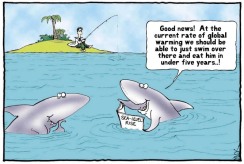 An interesting take on conference culture by Diogo Veríssimo (mastermind behind I Fucking Love Biodiversity).
An interesting take on conference culture by Diogo Veríssimo (mastermind behind I Fucking Love Biodiversity).
—
Just a few weeks back, more than 2000 conservationists got together in Montpellier, France, for the 27th International Congress on Conservation Biology (ICCB). I have been attending these conferences since 2008, and once again had a blast. Yet as I went through the usual talks, posters, work meetings, and this and that social, I could not help but feel that the traditional conference model was hindering, not helping me, maximise my benefits.
In my experience of conservation conferences, the content is largely delivered via a one-way channel, and attendees listen passively until the chance for a question or two comes up at the end. If time allows, that is, and it rarely does. Given the huge costs (and the footprint) of these events, how can we maximise the outcomes of these meetings?
Let’s look first at what is currently the backbone of most conferences anywhere: the oral presentation. Currently, the gold standard for the vast majority of ICCB presenters is the 15-min presentation, and those who are denied that chance often say they have been “downgraded”. I find this unfortunate.
My biggest criticisms of our current approach to content management during a conference is that it leaves the discussion to happen informally and without the benefit of the collective knowledge that comes together at these meetings. Many conservationists are keen to avoid long-winded lectures in their classrooms, but when we come together, those concerns seem to go out the window. The Q&A after a talk should be the most important part of a session for either the presenter (expert feedback can save a lot of time and resources) and the audience (who otherwise cannot focus on what they think is important).
Giving sessions enough Q&A time, which I argue would have to be as long as the time given to presentations, would imply having fewer presentations — unless we have shorter presentations. The ICCB already has the speed presentation, a format that lasts just 5 minutes. Why not make that the default? Yes, presenting your content effectively in 5 minutes is an acquired skill, but not much different in kind from writing an abstract to a paper. Having presented in both traditional and speed format, I am convinced presentations strongly suffer from the law of diminishing returns, meaning the difference from the audience point of view ends up being small. This is particularly true if fewer talks means more time for the audience to interact and ask about the things in which they are interested, rather than what the presenter thinks they should learn. Read the rest of this entry »






